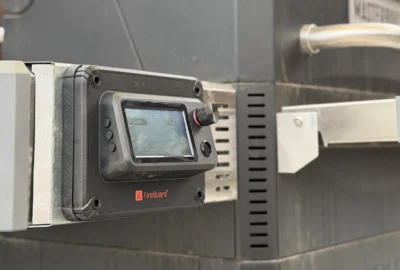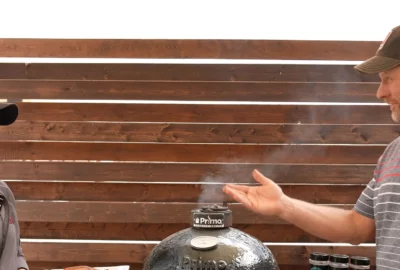Science, Smoking & Grilling World, Uncategorized
Maillard Reaction: Where Flavor and Temperature Meet
Following up on Jeff’s post comparing low and slow to hot and fast cooking methods, we are going to look at some of the chemical reactions taking place during the cooking methods. First, we have the Maillard Reaction. The Maillard Reaction is a reaction between amino acids and reducing sugars to create new compounds resulting in a brown crust on food. This reaction occurs when you are searing steaks or burgers on the grill, baking bread in the oven, deep frying French fries, or smoking a brisket.

Both the pork butt (above) and ribeye (below) achieved the Maillard Reaction using the FireBoard 2 Drive. The pork butt was cooked low and slow over night using the Drive fan to maintain a steady 200 degree temperature. See the graph further down in the article for more details. The ribeye steak was cooked using the reverse sear method. The steak was cooked at 225 degrees inderectly on the grill then the Drive was turn to 100% to get the great sear on the exterior. By turning the fan to 100% with lump charcoal we can achieve a very high temperature of 600+ degrees to get the great sear on the exterior.
Let’s dive into the primary variables that influence the Maillard Reaction: time and temperature. Think of the reactions as happening on a sliding scale balancing time and temperature. The sweet spot in the middle is around 300 degrees Fahrenheit but you can slide down to a lower temperature for longer time or slide up to a higher temperature for a shorter period. What you are cooking will determine where on this scale you are cooking.

Picking the right method for the cut you are cooking is crucial to achieving the Maillard Reaction. The steak on the left achieved the Maillard Reaction across the entire steak due to the hot and fast sear. The steak on the right needed more time with direct heat and was left left looking pale and grey.
The different times and temperatures will bring different flavors even on the same cut of meat. Chicken grilled directly over coals versus roasted with indirect heat will have different flavor profiles. Some of these flavor variations are due to differences in the Maillard Reaction at different temperatures but some of the variation is due to additional reactions happening in conjunction with the Maillard Reaction.

A graph of the FireBoard Drive program I used to maintain low and slow cooking to create the great bark on the pork shoulder at the top of the page. Started the butt at 200 degrees for 12 hours to develop a good smoke ring in addition to great bark on the exterior. After 12 hours the temperature was increase to 300 degrees and the butt was wrapped in foil with brown sugar, honey, and Blue’s Hog Tennessee Red. This higher temperature allows the sugars to caramelize in the short period until the butt finished cooking.
Low and slow cooking of a brisket will create a great bark on the exterior of the meat but also allows for the breakdown of connective tissue into gelatin. The gelatin sticks to your lips combining with the Maillard Reaction to create an unctuous mouth feel and umami flavor. Hot and fast cooking will allow for caramelization of sugars to happen. Caramelization combined with the Maillard Reaction results in great flavor, but too much caramelization results in pyrolysis which gives off an acrid burnt flavor.

One of the briskets from the FireBoard American Royal party. The bark was achieved by cooking at 190 degrees for 14 hours before being wrapped in butcher paper and finishing at 300 degrees for another two hours.
Balancing the need to create the delicious Maillard effect while achieving the desired doneness may require using multiple cooking methods. If you cook a steak at 225 degrees, the interior will be well done before the crust on the exterior forms but if you only sear it hot and fast the exterior may burn while the interior is raw. By utilizing the reverse sear, you start the steak low and slow in a sous vide, oven, or grill then finish hot and fast directly over coals or in a pan. This creates a great crust on the steak while keeping the interior at the perfect doneness.

The reverse sear method resulted in the great exterior crust and even doneness all throughout the steak. The Drive fan made it easy to maintain the low and slow temperature to start then kick up the heat to finish with the sear. Started the tri-tip at 250 degrees indirectly on the Primo grill until the steak achieved and internal temperature of 125 degrees. Once the internal temperature was achieved the steak was rested for a few minutes to allow the grill to come up to 600+ degrees in a direct grilling setup. Once the grill came up to temperature the steak was seared for 90 secondes on each side at the higher temperature.
There are many factors which play into achieving the perfect cook but no matter what you are trying to accomplish the FireBoard 2 Drive allows you to hit the exact temperature you need for your desired results. It will give you peace of mind for the low and slow all night brisket cook as well as maximizing the temperature of your grill to sear a steak. Using the FireBoard app to keep notes and pictures will allow you to easily replicate your cook in the future. We hope this will encourage you to experiment with different methods to find what you like best!









Leave a reply